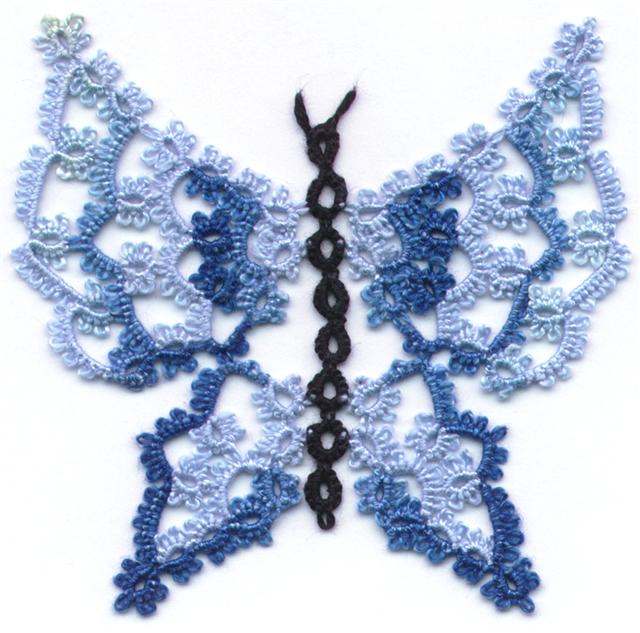The other thing I really like about this edging is that it's easy to adjust it to go around corners. The flower shapes make an instant corner treatment, without any extra work. As long as you position one of the flower shapes straddling the corner you can stretch or shrink the edging to fit just about any length. Most of the hankies you buy are approximately 11 inches along the side. Very approximate. The one I'm currently working on is 11 inches wide and 11 3/4 long, more or less. It may not be perfectly rectangular. Hankies often aren't perfectly square or rectangular. So we have to be creative about how we attach ore perfect laces to imperfect edges.
This edging allows for connecting 2 picots on each chain which gives a secure attachment to the fabric, but the flower shape allows for a lot of flexibility in between. So I end up with 12 flower shapes from corner to corner on one side and 11 on the other side but my corners are always flowers and unless someone stops to count pattern repeats, you'd never know.
There are 3 different ways of attaching edgings to fabric. You can tat directly onto the fabric and this works, but I'm not crazy about how it looks. I've only ever done a few times. The first time I was working in white thread on a white hanky with prepunched holes along the edge and I tatted directly into the holes along the hanky edge, using the holes instead of a picot for joining into. The next time I tatted directly onto the fabric, the hanky didn't have prepunched holes. I used the tip of the attached hook on my shuttle to wiggle aside the weave of the threads in the fabric to make my joins.
In a pattern like this one you have to make sure that you line up the pattern so that you have the right number of holes to match joining points as you come to the corner. Depending on the corner treatment you use you may need a fixed number of spaces around the corner for it to even if you have preset holes, you might need to create some extras to make things fit.
The last time I did a direct join attachment, it was a hanky with a pink floral print in the centre, surrounded by a white border and a scalloped edge. I used pink thread to match the predominant colour in the design and joined directly to the fabric. I was happy with the results until I saw it on display along the edge of the shelf in my sister's hutch. She had taken several hankies and displayed them under various pieces of china so that the lace edges showed. It looked awful. It probably looked OK to everyone else, but all I could see was the twists and turns of the pink thread joins over the white fabric as they followed the scalloped edge. YUCK!
The second method for attaching lace to fabric, is to create a foundation row that you can either tat the lace onto or sew it onto. You can do a row of single crochet along the edge of the fabric like this one pictured. Or you can do a row of blanket stitch, either by hand or by machine. Whether you use a blanket stitch or a crocheted row, all you are doing is making something that you can use to attach the lace. Again, you can either join directly onto the foundation row or you can sew the lace on to it. This prepared hanky is one I received with some thread I bid on.
My preferred method is to sew the finished lace onto the fabric using a blind stitch. Select a thread colour that matches your lace and a fine needle. The needle needle to be slim enough to fit inside the hem of the fabric. I start by carefully sliding the needle between stitches under the hem and out through the edge of the fabric. Then I tie a knot in the doubled thread and cut close to the knot. When I pull the thread tight, the knot slips under the hem and holds secure. Then I run the needle through the picot and back down right next to where I came up. Like this:
Then I run the needle along under the edge of the hem and come back up where the next picot is to be attached. This is called blind stitching because you don't ever see the thread that's holding the lace on to the fabric. You see fabric, then you see lace, looking like it's floating along the edge.
When I'm attaching lace to a hanky, I figure out what's happening at the corner first. Typically pattern repeats fit in an orderly number of spaces, but if a corner needs a fixed number of joins before and after, the lace on either side of the corner may need to be adjusted. Once I've figured that out, I begin joining the lace BEFORE the corner. It may only be half a pattern repeat, but it's before the corner. You can see in the upper left corner of the hanky in progress, that there's a short piece of unattached lace. That's the bit that the final section of lace has to join into. All of my adjusting position will happen along the edge, not right at the corner. It just gives me a lot more wiggle room if I have to nudge things and I don't end up with the corner looking buckled or the lace looking stretched.
We go to a lot of effort to make beautiful lace and it can be spoiled when our perfect lace is attached to less than perfect fabric edges. So it's nice to have a pattern that goes with the flow allowing me to enjoy the process instead of getting stressed out by it.












